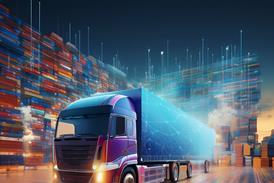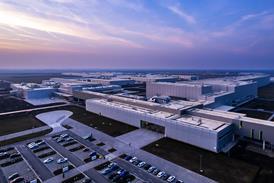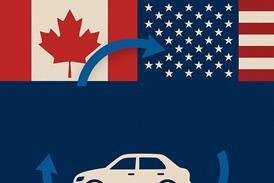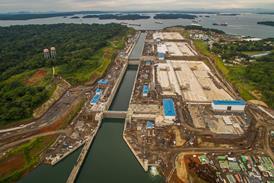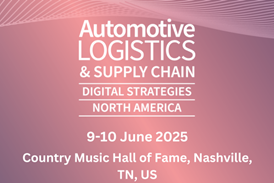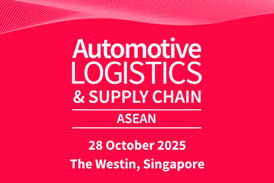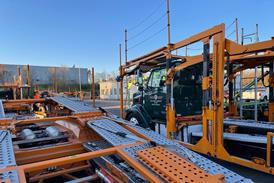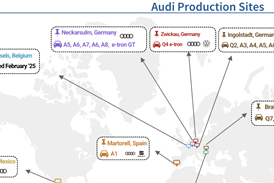Finished vehicle logistics – Page 28
-
 News
NewsFord to end passenger car production in Russia
Ford will end passenger car production at all three of the assembly plants it runs in Russia with Sollers by the end of this year
-
 News
NewsVolvo on track from China to Belgium with ARS Altmann and ICL
German vehicle transporter ARS Altmann and Intermodal Container Logistics (ICL) have transported Volvos by train between Xi’an in China and Gent, Belgium.
-
 News
NewsRenault returns to Nigeria with Coscharis
Renault has outlined plans for the distribution of four vehicles in Nigeria from October this year, which includes local joint venture production from semi-knockdown (SKD) kits of two models and the import of finished vehicles from Brazil…
-
 News
NewsHödlmayr shipping Dacia vehicles to Germany
German finished vehicle carrier Hödlmayr has taken over the contract to ship Dacia volumes from parent company Renault’s plant in Pitesti, Romania, to dealers in Germany. Hödlmayr Logsitics Romania will move between 250-300 Dacia vehicles per week by blocktrain in conjunction with road transport services Hödlmayr’s division ...
-
 News
NewsMitsubishi and Nissan streamline logistics in Japan and US
Japanese company Zero is taking over the domestic finished vehicle logistics for Mitsubishi Motors from August this year. Those services were provided by the carmaker’s subsidiary Mitsubishi Automotive Logistics Technology (MLT), which will in future focus on its maintenance and repairs operations…
-
 News
NewsUkraine introduces embargo on vehicle imports from Russia
Since the beginning of July Ukraine’s government has prohibited the import of any vehicles or parts made in Russia, regardless of from where the shipment is coming or whether it is staying in Ukraine. The move is part of wider retaliatory sanctions on a range of products from Russia. ...
-
 News
NewsGM boosts Cruze imports through Itajaí over first year
In one year of handling finished vehicles on behalf of GM, the Brazilian port of Itajaí reported throughput of almost 25,800 units by June 8, 2019. By the end of June, that figure had risen to more than 27,000 units. Trials began on 9 June 2018, ...
-
 News
NewsSpate of violent attacks against trucks in South Africa threatens automotive industry
South African truckers will hold a ‘Black Friday’ protest on July 12 to highlight a series of attacks across the country that has destroyed hundreds of vehicles and left dozens dead and injured. More than 1,400 trucks have been destroyed or damaged in the past year, according ...
-
 News
NewsDeep-sea vehicle carriers sail further into troubled waters
Stagnant vehicle shipments, rising regulatory costs and sinking vessel utilisation are all affecting the ocean transport sector, according to data from Drewry Shipping Consultants. With shipping rates at relative lows, new vessel orders for pure car and truck carriers (PCTCs) have stalled to a virtual ...
-
 News
NewsUsing the past to better predict the future of vehicle logistics
In finished vehicle logistics and distribution, disruptions and changes in the supply chain often lead to higher costs and bottlenecks, including stock pileups and imbalances in transport capacity. Last year’s implementation of WLTP in Europe was a case in point, as some OEMs faced delays in getting vehicles certified or ...
-
 News
NewsAPLL Vascor increases finished vehicle rail capacity
Indian logistics joint venture, APL Logistics Vascor Automotive (APLL Vascor), has increased its fleet of finished vehicle carrying rail wagons to 16 rakes, with an additional four rakes to be delivered this year. Each rake comprises 27 wagons and has capacity for up to 318 passenger vehicles, but can also ...
-
 Feature
FeatureNorth American ports go in search of the promised land
US east coast ports have been grabbing land to handle increased volumes while some on the west coast deal with dramatic volume fluctuations. In Mexico, meanwhile, private investment is helping to deal with congestion. Marcus Williams reports on the performance of North American vehicle handling ports in 2018
-
 News
NewsFord sets up Import division for Europe
Ford has launched the reorganisation of its business in Europe under three new groups, each with its own dedicated management: Commercial Vehicles (CVs), Passenger Vehicles (PVs) and Imports. The move is designed to improve customer-centred decision making and part of a previously announced reorganisation. Ford currently ...
-
 Feature
FeatureStronger ties: Growth of a new Silk Road
Increased investment in rail services across Eurasia is contributing to rising volumes of automotive shipments via this mode – not only components but finished vehicles as well
-
 News
NewsPeel Ports on a roll at Sheerness
Peel Ports has spent £5.5m ($7m) replacing the Royal Bridge Pontoon to increase overall throughput capacity at Sheerness, part of the London Medway cluster of ports…
-
 Interview
InterviewSteering the future using AI
German start-up Kopernikus has developed self-driving technology that can be used to move vehicles inside production facilities and workshops, and potentially even at ports…
-
 News
NewsBrazilian vehicle sales help to offset export decline to Argentina
Domestic demand for vehicles in Brazil is helping to offset a decline in export sales because of the economic slowdown in neighbouring Argentina, which is Brazil’s main automotive export market. However, according to research commissioned by the national association of automotive vehicle manufacturers in Brazil – Anfavea – it is ...
-
 News
NewsHard Brexit fear haunts UK's finished vehicle sector
British vehicle transporter ECM has expressed concerns about implications for the automotive industry should the UK exit the European Union (EU) without an agreement on October 31
-
 Feature
FeatureAutonomy ahoy: Shipping industry moves toward crewless vessels
Autonomous vehicles have been attracting a lot of attention as the automotive industry pushes towards future mobility. But what is the potential for autonomous ships?
-
 Feature
FeatureAll mixed up: the impact of the SUV trend on European car carriers
Volumes of finished vehicles may have recovered from the recession, but users and manufacturers of car transporters are now having to handle a very different array of vehicles, including larger and heavier models – with implications for capacity utilisation




